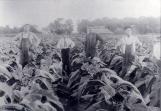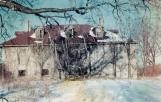2
Glass Half Empty - The Waxing of the Grapes"That the citizens of Pelee Island are enterprising cannot be disputed , the adoption of an extensive drainage system, whereby thousands of acres of marshlands have literally been converted into gardens, the providing of landing places for boats and other modern improvements necessary for the development of the resources of the Island, show them to be both progressive and enterprising and by a combination of the thrift, industry and intelligence of the people with the natural advantages of a general climate and adaptability of the soil, the future destiny of Pelee Island can better be imagined than described. Among the industries which will be fostered is the growing of tobacco, Dr, W.B. Scudder, of Cincinnati, Ohio having kindly contributed the seed as well as placed to credit of the [Agricultural] Society a donation in money to be awarded as premiums for the best half acres of tobacco grown."
Perhaps it was the introduction of Tobacco seed to the Island in 1895 by Dr. W. Bird Scudder that was the first domino to fall. With the draining of the marshes and the advent of the 20th century, the future of the Island was ripe for vineyard expansion and a passing of the torch to a new generation of grape growers. But with the lure of tobacco and other favourable crops, to the passing on of the original Pioneers and the start of WWI and Prohibition, the momentum had begun to see the end of an era for grape growing and wine making on not only Pelee Island but in all of Essex County.
Acres of vineyards were literally taken up in favour of planting tobacco. One such case was that of Mr. Atkinson, who planted a large acreage of tobacco because as he says: 'the price paid for the grapes by the wine manufacturers was not enough to pay for the raising'. So with the grape market depressed for such a sustained period of time, it could not hold the interest of the farmers, especially in the face of a growing tobacco market. But even still, by 1912 Major J.S. Hamilton reported a great yield that year for the grape harvest. Unfortunately for him, it was also a good yield for everything else:
"the Island also produced 10,000 bushels of potatoes, 15 000 bushels of wheat, 7500 bushels of barley, and one million pounds of tobacco."
3
Workers in Tobacco FieldCirca 1920
Pelee Island, Ontario
 Credits:
Credits:Creighton J. Hamel Collection
Pelee Island Heritage Museum
5
J.S Hamilton saw the dominance of the grape shift to tobacco and it was not long after that the Pelee Island Winery Company would consider ceasing its pressing operation on the Island. In a failed attempt to move the location of the wine press to the Niagara region, the Pelee Island Winery expanded its operation in Brantford. In 1914, J.S. Hamilton announced, on his visit to the Island, that it would be the final year that he would purchase grapes from Pelee Island. In the following year, A.M. McCormick's store burned down. This advantageous event was a bitter sweet mark that saw an end to the 43 year old partnership of J.S. Hamilton and Pelee Island as the Wine House was sold to A.M. McCormick and Son in 1916. The community store lived on, now housed in the vacated shell that was, in many an Islander's mind, the indelible image that made Pelee.6
Pelee Island Winery Store and Cellar in BrantfordCirca 1927
Brantford, Ontario, Canada
 Credits:
Credits:Brantford Expositor; Semi-Centennial Edition, 1877-1927
7
As the presence of J.S. Hamilton and associates on the Island was waning, many of the pioneers of the Island's wine industry passed away: Adelia Smith, November 3rd, 1893; Thaddeus Smith, June 11th, 1902; John Wardroper, June 16th, 1901; and his brother Edward Wardroper, November 12, 1908. The Rehberg's had left the Island in the mid 1890's and had sold off all their large wine casks. Thaddeus Smith's family, Edward and Minnie Bird Wardroper stayed at Vin Villa until November of 1906. They moved to Ypsilanti, Michigan but Minnie Bird did come back to the Island every year to run Vin Villa as a boarding house. In 1923, Vin Villa was sold to Dr. Riel Hillier of Leamington. Dr. Hillier extended the life of grape growing on the Island, as he restored the original vineyards on the property and sold grapes to a variety of vendors. "Island residents remember as many as one hundred bushels of Catawba grapes awaiting shipment in the dock warehouse". In the year 1939, John and Catherine Hartman took over the residency of Vin Villa. They also continued in the wine making tradition but this time only to friends and family. Vin Villa shrank down from its International renown down to a family farm. After 1940, there were few, if any, grapes shipped off the Island.In a span that lasted over 30 years, the region of Essex County reigned in the growing of grapes and the production of wine. By 1890, 23 out of 41 wineries in all of Canada were located in the Pelee Island-Windsor corridor. Two-thirds of the grapes grown in Canada were from Essex County. At its apex there was almost 2000 acres of vineyards but that number fell to just over 50 acres by 1921. There were 35 wineries in Ontario in the 1890's, as well, in contrast to 9 by 1915. The industry, once a full bottle, was now but a half-empty glass. Amalgamations were another contributing factor in the demise of the smaller wineries. The Pelee Island Winery and Company became the J.S. Hamilton Company in 1918. After the death of J.S. Hamilton in 1931, his nephew, T.R. Hamilton took over the business. The London Winery bought out the business in 1945. In Essex County, over 15 wineries ceased operating or were bought out by larger companies. The Girardot Winery that once vied for Pelee Island grapes was sold to the Fred Marsh Winery of Niagara Falls in 1935. It has been observed that, "...of the half dozen or so wineries that appeared after 1908 in the Windsor area, not one survived beyond 1938. In each case the new wineries were absorbed by the larger and older wineries, like Bright's, the London Winery, and Parkdale Wines."
9
Vin VillaCirca 1961
Pelee Island, Ontario
 Credits:
Credits:Lalonde-Dobson Collection
Pelee Island Heritage Museum
10
Prohibition came into Ontario in 1916 and lasted until 1927. During this time the sale of beer and liquor were banned. Native Wines were exempt, under Section 44, but could only be sold at on-site stores at the wineries or doctors could prescribe wine for 'ailments' to patients. When Prohibition started there were 10 wineries operating and by 1926 the Board of Liquor Commissions had granted 57 licenses to new wineries. It was because wine was allowed to be bought and prescribed that it made Canadians into being great wine consumers - in 1920, Canadians consumed 221,985 gallons of wine and by 1930, they consumed 2,208,807 gallons. Despite all of this, the grape growing days of Pelee Island and Essex County were gone. Prohibition was the final domino to fall but was not, by any means, the reason for its demise.In 1935, the former Wine House of the Pelee Island Winery, now the A.M. McCormick store, went up in flames. The structure does not exist anymore. As if that wasn't enough to take away from the historical edifices of the Island, in 1963, Vin Villa was set ablaze. The ruins can still be seen today like some Greek temple to Dionysus where the legend of Thaddeus Smith lives on and is not forgotten.
Source:
Amherstburg Echo
The Vinedressers, Ron Tiessen, Pelee Island Heritage Center, 1997
11
Wine House on Fire1935
Pelee Island, Ontario
 Credits:
Credits:Creighton J. Hamel Collection
Pelee Island Heritage Museum
12
Pelee Island Wine vat, formerly used for wine, now water reservoirCirca 1923-24
Pelee Island, Ontario
 Credits:
Credits:National Archives of Canada


